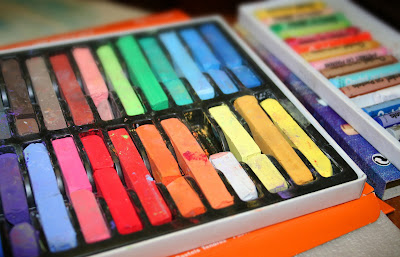1. Now that you know what you want to paint or draw, you need to make it work on canvas. How do you convince your audience of your work, create harmony (or “music”) in your artwork and keep their interest?
After covering your canvas with the background or “mood” colour, you need to compose your subject successfully on the picture plane. Successful composition leads the eye around the painted area in a harmonious and satisfying manner. A beautiful painting can become unattractive and unpleasant simply through bad composition! Here are some dos and don'ts:
Don't:

- Don't "frame" your object with a huge amount of empty space or by creating a colour "glow" around your objects.
- Don't try to squeeze objects into the picture plane, allow them to breath or at times break the canvas edge.
- Don't create too much symmetry in your artwork, especially around the center, also vary the sizes of objects in the image (for example patterns in an abstract).
Do:

- Make use of the rule of thirds (or the "golden rule" - 6/10) to compose your main subjects or focal points. Keep away from the center by using the available (or negative) space to its full potential.
- Compose your objects in such a way to allow the eye to move comfortably over the picture plane, objects can break the edges of the canvas, but make sure it breaks it in more than 1 or 2 places, a singular break can lead the eye away from the subject. Diagonals are great for leading the eye.
- Place your main subject(s) off center or near a third to balance to canvas in a more harmonious way.
- Keep an eye out for the direction your subject is looking in and then leave more open space on that side. This keep your subject from staring into the edge of the canvas. Always give room for animals to "escape" by leaving a space in front of them (or below when painting birds).
If you are working with a conceptual meaning in your artwork, these rules can be broken in order to support your idea. Composition plays a significant role in aesthetics as well as conceptualization.
2. Perspective is the first step to creating realism and depth in an artwork. It is a way to create a 3 dimensional image on a 2 dimensional plane. To create successful perspective, one or more vanishing points need to be established on the picture plane towards which all the parallel lines in real life converge (most useful when painting buildings, roads, fences etc). These vanishing points exist on the horizon (or eye-level).
Examples of 1-point, 2-point and 3-point perspective respectively:

3. Depth perception can be achieved through different painting techniques as well as through the correct use of colour and perspective.
Perspectival depth – Creating depth by making use of 1-point, 2-point or 3-point perspective.
Atmospheric/Arial depth – Created by using duller, more faded colours toward the background and brighter colours in the foreground. Colours on the horizon gradually become closer to the colour of the sky.
Colour depth – Using cool colours in the background and warmer colours in the foreground. Shadows also contain cool colours. The use of complimentary colours can exaggerate this effect.
Focal depth – This works on the principle that areas closer to the foreground are painted in focus (more texture or detail) while areas in the background out of focus (soft or slightly blurred).
Happy painting!
